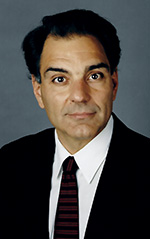Living Up to the American Idea
Besides the moral imperative, there are compelling reasons to have a Foreign Service that looks like America. Here are some suggestions for how to get there.
BY PETER F. ROMERO
In these unprecedented times, we ask ourselves how we went from a beacon of freedom and justice in the world to the faintest glow of an ember. We wax nostalgically about the glory days of U.S. diplomacy, when we were the “Indispensable Power,” and then sink into near despair about what we see today. We may think about how to get back to the kind of political consensus and unity of purpose that defined our policies for the 50 years following World War II. With so many daunting challenges, where do we even begin?
A first step is to accept responsibility for where we now find ourselves. For a long time, we Americans have seen, but not read, the writing on the wall. Whole swaths of our fellow citizens have been systematically excluded and left behind. The pervasive politics of victimization, zero-sum thinking and resentment complicates a comeback. As I see it, we have two choices. We can either recommit to our diversity and inclusiveness as a nation, the “American Idea”; or we can avert our eyes and hope that somehow the country will snap back to its senses.
But whichever way this goes, let’s remember: We are a piece of every part of the world. Every foreign leader knows that multitudes of their brethren call the United States home. It is not only guns and dollars that brought us to past heights. It is the American Idea.
A Stark Reality
I was always delighted, when walking into the office of a new contact, that I was regularly mistaken for my Foreign Service National assistant and the FSN for me because of his fair complexion. This American Idea not only inspires but has provided me and others with the ability to walk into a foreign authoritarian’s office and demand the release of unjustly imprisoned Americans or people tortured simply for exercising their rights.
But after more than 40 years of efforts, when it comes to racial, ethnic and gender inclusion throughout the ranks of the Foreign Service, we, as part of the State Department, have not succeeded in making the Service representative of who we are as a nation. The reality is stark. The January GAO report paints a dismal picture, with thinning numbers of diversity officers starting at the mid ranks and just three Black and four Hispanic career chiefs of mission worldwide. In some cases (read Hispanics) the wheels have been thrown into reverse. There are now fewer Hispanic officers in the Foreign Service than when I entered in 1977.
For ground truth, we need to hear from those on active duty. The new approaches will come from them, not from us gray hairs.
Bias, discrimination and a callousness toward staff continue to plague the State Department. This represents leadership shortcomings in supervisory ranks. Regrettably, the appointment of Secretaries of State Madeleine Albright, Colin Powell, Condoleezza Rice and Hillary Rodham Clinton have not had the deep and sustained influence on diversity and inclusion that many had expected. We can either continue to wait for that elusive “Secretary Godot,” or we can kick-start a recommitment to diversity and inclusion now.
Beyond the moral imperative of having a Foreign Service that looks like America, there are several compelling comparative advantages to reaching this goal. It would give us greater cultural and linguistic competencies, and arm us with deeper empathy and understanding—critical tools to influence friend and foe alike. In addition, it would generate more informed decision-making, and gain greater public support for the men and women who daily hazard political and physical threats to keep us safe and advance our interests.
We should start by getting our own house in order. That means a recommitment to the principle of inclusion in our Foreign Service.
Getting There: Practical Proposals
Here are a few suggestions for getting there.
■ Create a “Certificate of Leadership Competency.” This certificate evaluating an officer’s performance on diversity and inclusion would be a requirement for entry into the Senior Foreign Service. Since we will require this of all career officers, a non-State panel of retired senior FSOs and past political appointees should examine the leadership “fitness” of nominated political appointees and report these findings to the Senate.
■ Integrate current equal employment opportunity promotion precepts (now just a box to check) into the leadership principles.
■ Make mid-level officers accountable for developing all those supervised. Beyond leadership training, supervisors, in conjunction with their rating and reviewing officers, should be required to set specific diversity and inclusion goals for themselves, and be evaluated yearly on how well they were achieved.
■ Create a diversity and inclusion “scorecard” that measures the success of supervisors in the recruitment, retention, promotion and professional development of those they manage. Bonus pay could be given to those with high rankings.
■ Require rating and reviewing officers of the rated supervisor to reach out to all (or at least a good representative sampling) of her/his employees (via 360-degree assessments, employee satisfaction responses) in evaluating performance and counseling the supervisor, as needed.
■ Raise inclusive and effective leadership to the highest level of core competency for supervising officers; make it an absolute requirement in the precepts for promotion (at FS-2 and above).
■ Expand the role of representatives of more than a dozen employee affinity groups in formulating promotion precepts, volunteering for the panels and as a sounding board for future initiatives on diversity and inclusion, particularly in and into the senior ranks.
■ Select out those officers who show an abusive pattern toward staff, regardless of any other personal qualities, influence or achievements.
■ Develop and implement a system of exit surveys to determine why officers resign. Too many racial, ethnic minorities and women have resigned in the early and mid-ranks. There has not been even a minimum of follow-up to determine the reasons, let alone identify systemic patterns to address.
Listen to the Active-Duty Ranks
With respect to this last recommendation, a consistent complaint from our non-white officers is that their suggestions for new policy initiatives, tweaks to those that exist, or reforms to procedures are often met with silence or demeaning responses from supervisors: “You’re an FS-3. You need to just listen.” Such dismissiveness is fairly common at State; it certainly was when I was going up through the ranks.
Yes, millennials are impatient and cite the private sector as more welcoming to new ideas. They want to make a difference, now. This spirit should be nurtured, not shot down. Every challenge that our country now faces begs for new approaches and novel ways of dealing with it. There are several groups of ex-FSOs (in the American Academy of Diplomacy, AFSA and the Harvard Kennedy School, among others) that are currently engaged on the issues of diversity and inclusion and how our Service can most effectively meet the challenges of an uncertain future. But for ground truth, we need to hear from those on active duty. The new approaches will come from them, not from us gray hairs.
Morale is at a low ebb in the department. One sees more slouch than swagger. Let’s turn this around.
Read More...
- “America is Diverse, Why Aren’t Its Diplomats?” by Zack Stanton, Politico, July 31, 2019
- “Gender Representation and Diversity in the Foreign Affairs Community,” by Caroline Bettinger-Lopez and Rebecca Turkington, CFR, June 8, 2020
- “Building a Representative Foreign Service” by Congressman Gerry Sikorski, FSJ, July 1990




